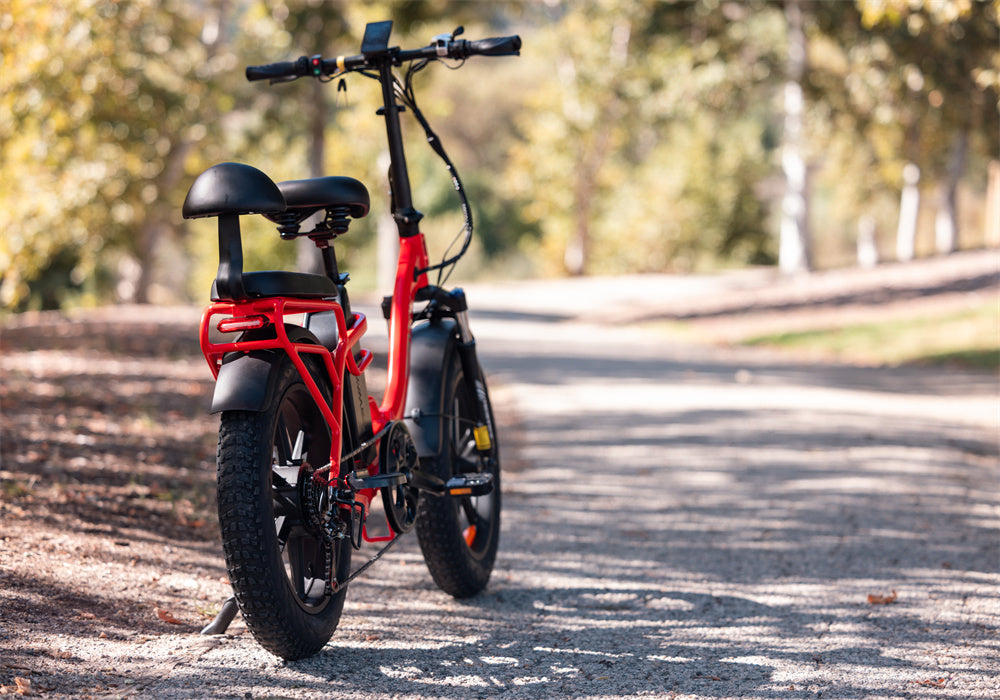As ebikes become more common on European roads, the legal landscape can be a bit tricky to navigate.
What speed limits apply?
How are electrical bicycle classified in different countries?
This guide will take you through the essential regulations, helping you understand everything from motor power limits to where you can legally ride, ensuring you're fully informed and ready to hit the road.
Ebike Regulations in Europe
Europe has seen a significant surge in the adoption of electric bicycles, leading to a wave of new laws and regulations designed to standardize their use across the continent.
While some rules are consistent, each country may have its own specific requirements, so it's crucial to familiarize yourself with local laws before heading out on your ebike.
What Defines an Ebike in Europe
In Europe, the term "ebike" is typically used to describe bicycles equipped with an electric motor that provides assistance to the rider.
There are distinctions between ebikes and motorized bikes. An ebike is legally defined as a bicycle that:
-
Has a maximum power output of 250 watts.
-
Offers pedal assistance up to 25 km/h (15.5 mph).
-
The motor only engages when pedaling (i.e., throttle-controlled bikes are often classified as mopeds).

SEE ALSO How Long Does an eBike Battery Last? Plus, How Much You Should Pay
European Union Ebike Standards
The European Union has standardized ebike classifications, which are crucial for understanding where and how you can ride your electric bike. In general, the EU classifies ebikes into two main categories:
-
Class 1 Ebikes: These are the most common type of ebike. They have a motor that provides assistance only when you pedal, and the motor cuts off when you reach 25 km/h (15.5 mph). These bikes are allowed on most bike lanes, roads, and even some trails.
-
Class 2 Ebikes: Also known as throttle-controlled ebikes, these bikes can operate without pedaling, using only the motor for propulsion. However, Class 2 bikes are subject to stricter regulations and may be restricted to areas where motorized vehicles are allowed, depending on the country.
-
Class 3 Ebikes: These bikes can assist up to 45 km/h (28 mph), which means they are typically classified as speed pedelecs. Due to their higher speeds, they are subject to stricter rules, including registration requirements and the need for a helmet.

Ebikes and National Laws
While the EU provides a general framework, each European country can impose its own regulations on ebikes. Below are some notable regulations in key European countries.
Germany
Germany is one of the leading countries for ebikes in Europe, and its regulations are well-established.
In Germany, Class 1 and Class 2 ebikes are generally treated as regular bicycles, allowing riders to use bike lanes and paths. However, Class 3 ebikes (speed pedelecs) are treated like mopeds, and riders must have a license plate and wear a helmet. Additionally, speed pedelecs are only allowed on roads or designated paths, not bike lanes.
France
In France, ebike regulations are also clear and favorable to riders. Class 1 ebikes are allowed on all public roads, bike lanes, and pedestrian zones.
However, like Germany, Class 3 ebikes are treated as motor vehicles, requiring helmets and insurance.
It’s important to note that French cities often encourage eco-friendly transportation, making it easier for ebikes to integrate into urban infrastructure.
Italy
In Italy, ebikes are allowed to travel on public roads, but the distinction between pedal-assist ebikes and throttle-controlled bikes is crucial.
Pedal-assist bikes follow the same regulations as regular bicycles, while throttle bikes are often subject to restrictions, especially in urban areas. Additionally, speed pedelecs are required to be inspected and registered.
Spain
Spain has an increasing number of ebike riders, with regulations that mirror those of other European countries.
Class 1 ebikes are allowed on bike paths and roads, while Class 2 and 3 ebikes require additional permits and can only be used on certain roads.
Helmets are mandatory for speed pedelecs and are recommended for all riders, even for regular ebikes, depending on the region.
The UK
After Brexit, the UK continues to follow similar rules for ebikes as those outlined by the EU.
Class 1 ebikes are allowed on public roads and bike lanes, while
Class 3 ebikes are considered motor vehicles and require registration, insurance, and a helmet. Local councils may impose additional restrictions, especially in urban areas.
Ebikes and Helmet Laws
In most European countries, helmets are recommended but not mandatory for regular ebike riders on Class 1 bikes.
However, Class 3 speed pedelecs almost always require a helmet by law, regardless of the country.
This regulation is in place due to the higher speeds these bikes can reach.
Where Can You Ride Your Ebike in Europe
When it comes to where you can ride your ebike, the general rule is that Class 1 ebikes are allowed in bike lanes and most public areas, while Class 2 and 3 ebikes may face restrictions.
Many countries have established eco-friendly zones in urban centers, where ebikes are encouraged, and cities like Amsterdam and Copenhagen have developed extensive ebike infrastructure.
Ebikes in European Cities
Several cities across Europe are well-equipped to accommodate ebikes, offering not only dedicated bike lanes but also charging stations and bike-sharing programs.
In cities like Berlin, Paris, and Barcelona, ebikes are a popular form of transportation.
These cities have implemented policies that make it easier to navigate through urban areas while minimizing environmental impact.
Electric Bike Insurance and Registration
While Class 1 ebikes usually do not require registration or insurance, speed pedelecs (Class 3) are often treated as motor vehicles, necessitating insurance and, in some countries, registration.
In Germany, for example, all speed pedelecs need to be registered, and the rider must have insurance. In France, similar rules apply, with a mandatory helmet and insurance for higher-speed bikes.
You Need a Long Range Bike
The Tesway X7 Pro and X5 Pro are designed to meet the needs of riders who demand both power and endurance, combining cutting-edge features with impressive performance.
With a 1600W Peak Motor, these bikes offer a torque of 100N.m, allowing you to tackle steep inclines and challenging terrains with ease.
The speed of up to 50 km/h ensures that you can keep pace with traffic or zip along your favorite cycling routes without any hassle.
The 52V 60Ah battery provides an incredible range in pedal assist mode—up to 320 kilometers on a single charge.
This means you can enjoy longer rides without the constant worry of running out of power. Equipped with hydraulic disc brakes, the Tesway X7 Pro and X5 Pro offer superior stopping power for added safety, whether you’re navigating busy streets or cruising on remote trails.
If you’re in the market for a bike that combines long-range capabilities, powerful performance, and advanced safety features, the Tesway long-range ebike models like the X7 Pro and X5 Pro are a fantastic choice.
Get ready to ride farther and explore more with confidence!
Conclusion
As the popularity of ebikes continues to grow across Europe, each country has tailored its regulations to ensure safety and promote the use of eco-friendly transport.
Class 1 ebikes are widely accepted and can be ridden on most bike paths and public roads, while Class 3 speed pedelecs are subject to stricter rules.
FAQs
Do I need a license to ride an ebike in Europe?
In most European countries, you do not need a license to ride an ebike, provided it falls within the standard EU classification of a pedal-assist bike with a motor of no more than 250 watts. However, if your ebike exceeds this power limit or has a throttle, you may need to register it and acquire a license, depending on the country.
Are there specific ebike insurance requirements in Europe?
In most countries, ebikes that meet EU standards do not require mandatory insurance. However, if you have an ebike that exceeds the 250W limit or qualifies as a moped, insurance may be required. It’s always wise to check with local authorities or an insurance provider to ensure you're covered in case of accidents or theft.
Do I need to wear a helmet when riding an ebike in Europe?
Helmet laws vary across Europe. In many countries, wearing a helmet is not mandatory for cyclists riding an ebike that meets the EU standard (250W motor, 25 km/h limit). However, it’s highly recommended for safety reasons. Countries like Spain, Italy, and Portugal may have stricter helmet laws, especially for younger riders, while other countries might not enforce helmet use for adults. Always check local regulations before heading out.
Don't Miss These
Single vs. Dual Battery: Which is Best for Your E-Bike?
TESWAY’s Black Friday Sale: Unbeatable Deals on Long-Range Electric Bikes!
Reasons Why Electric Bikes Are Perfect for Seniors
Electric Bike Tire Pressure Best Practices
How Fast Will a 1000W Electric Bike Go?






Share:
What is the Lifespan of E-Bike Battery?
What is the Power Limit for Ebikes in the EU?